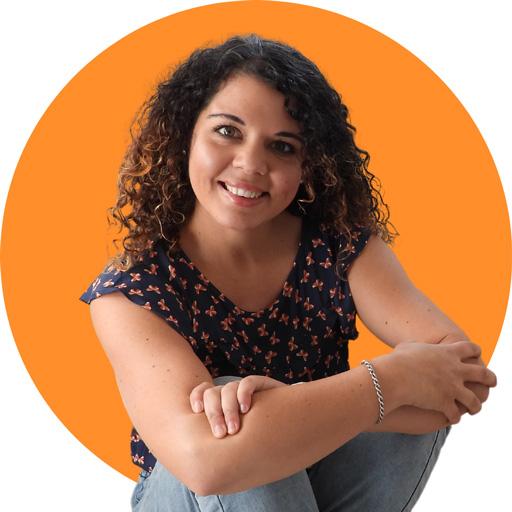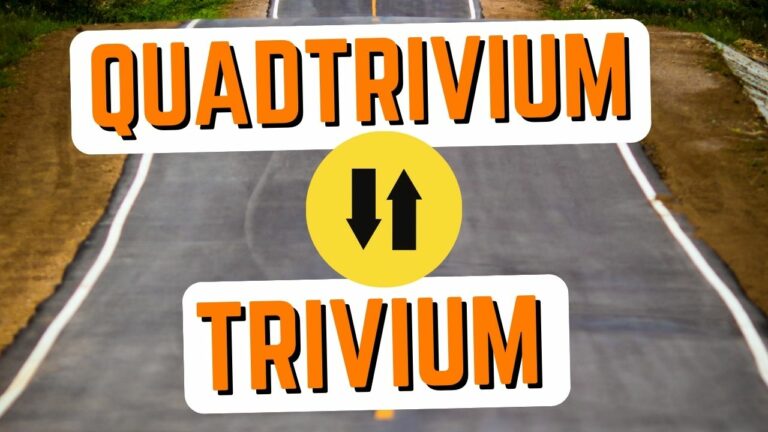When delving into the realm of classical education, two fundamental terms emerge: the Trivium and the Quadrivium. These ancient educational frameworks have stood as guiding principles for centuries, shaping the intellects of scholars and fostering a holistic understanding of the world. In modern times, a thread of classical educators with Christian roots have woven theology in too. Join us on a captivating journey as we delve into the difference between the trivium and the quadrivium, unveiling their distinct purposes and contributions to a well-rounded education.

I hope you enjoy reading this blog post. If you want to do my course on how to homeschool, click here.
 The Difference between the Trivium and Quadrivium
The Difference between the Trivium and Quadrivium
An expert in classical education, Dorothy Sayers explained the difference between the Trivium and the Quadrivium in this way:
The syllabus was divided into two parts: the Trivium and Quadrivium. The second part—the Quadrivium—consisted of “subjects,” and need not for the moment concern us. The interesting thing for us is the composition of the Trivium, which preceded the Quadrivium and was the preliminary discipline for it. It consisted of three parts: Grammar, Dialectic, and Rhetoric, in that order. – Dorothy Sayers, Lost Tools of Learning, p. 5.
Further down the page, I’ve put some more exerps from Sayers in, but before we look at them, let’s look at the basic question.
Understanding the Trivium
The Trivium forms the foundation of classical education and consists of three core stages related to children’s natural development:
- the grammar stage,
- the logic stage, and
- the rhetoric stage.
Each stage builds upon the other, providing students with essential tools for critical thinking, effective communication, and a deep understanding of language.
The Grammar Stage
The first stage of the Trivium focuses on acquiring a comprehensive knowledge of language (often through Latin), including vocabulary, syntax, and grammar rules.
By mastering the fundamental building blocks of language, students develop a strong foundation for effective communication and understanding.
The Logic Stage
In the logical stage, students learn the art of reasoning and logical thinking.
They explore formal and informal logic, learning to identify fallacies, analyze arguments, and construct sound reasoning.
This stage equips students with the skills needed to think critically, evaluate information, and engage in intellectual discourse.
The Rhetoric Stage
The final stage of the Trivium centers on the art of persuasive communication.
Students refine their ability to express themselves eloquently, developing effective public speaking and writing skills. The study of rhetoric empowers students to articulate their thoughts persuasively and engage in meaningful dialogue, fostering confident and influential individuals.
The Essence of the Quadrivium
While the Trivium focuses on language and critical thinking, the Quadrivium extends the educational journey to embrace the world of mathematics, sciences, and the harmony of the universe.
Comprising four disciplines, the Quadrivium aims to deepen students’ understanding of the mathematical and scientific principles that govern our reality.
Arithmetic
At the heart of the Quadrivium lies the study of numbers and basic mathematical operations. Arithmetic provides a solid foundation for higher-level mathematical concepts, enabling students to solve problems, analyze data, and perceive patterns.
Geometry
Geometry explores the properties, shapes, and relationships of objects in space. It offers a tangible way to understand abstract concepts and develops spatial reasoning skills. By studying geometry, students gain insight into the order and symmetry present in the natural world.
Music
The study of music goes beyond mere appreciation; it delves into the mathematical principles underlying harmonies, rhythms, and melodies. Through the Quadrivium’s musical component, students explore the mathematical patterns embedded within music, fostering a deeper connection between mathematics and the arts.
Astronomy
Astronomy unveils the mysteries of the universe, guiding students in their exploration of celestial bodies, planetary movements, and cosmic phenomena. It merges scientific observation with mathematical calculations, providing insight into the vastness and precision of the cosmos.
Another Thing!
Another thing to know is that the trivium and quadrivium are called the 7 liberal arts, and they comprise the whole of classical education.
Generally, the trivium is done at school, while the quadrivium can be done at any time, usually in college.
Dorothy Sayers on The Difference Between the Trivium and Quadrivium
I can’t highly recommend Dorothy Sayer’s Lost Tools of Learning more highly.
It is a must-read for anyone seriously considering giving their children a classical education.
I think it necessary, in these days, to go back to a discipline which we had discarded. The truth is that for the last 300 years or so we have been living upon our educational capital. The post-Renaissance world, bewildered and excited by the profusion of new “subjects” offered to it, broke away from the old discipline (which had, indeed, become sadly dull and stereotyped in its practical application) and imagined that henceforward it could, as it were, disport itself happily in its new and extended Quadrivium without passing through the Trivium. But the scholastic tradition, though broken and maimed, still lingered in the public schools and universities: Milton, however much he protested against it, was formed by it—the debate of the Fallen Angels, and the disputation of Abdiel with Satan have the tool-marks of the Schools upon them, and might, incidentally, profitably figure as a set passage for our Dialectical studies. Right down to the nineteenth century, our public affairs were mostly managed, and our books and journals were for the most part written, by people brought up in homes, and trained in places, where that tradition was still alive in the memory and almost in the blood. Just so, many people to-day who are atheist or agnostic in religion, are governed in their conduct by a code of Christian ethics which is so rooted in their unconscious assumptions that it never occurs to them to question it. – Dorothy Sayers, Lost Tools of Learning, pp. 17-18.
Do you often come across people for whom, all their lives, a “subject” remains a “subject,” divided by water-tight bulkheads from all other “subjects,” so that they experience very great difficulty in making an immediate mental connection between, let us say, algebra and detective fiction, sewage disposal and the price of salmon, cellulose and the distribution of rainfall—or, more generally, between such spheres of knowledge as philosophy and economics, or chemistry and art? – Dorothy Sayers, Lost Tools of Learning, p. 3.
The syllabus was divided into two parts: the Trivium and Quadrivium. The second part—the Quadrivium—consisted of “subjects,” and need not for the moment concern us. The interesting thing for us is the composition of the Trivium, which preceded the Quadrivium and was the preliminary discipline for it. It consisted of three parts: Grammar, Dialectic, and Rhetoric, in that order. – Dorothy Sayers, Lost Tools of Learning, p. 5.
[T]he Trivium is by its nature not learning, but a preparation for learning. – Dorothy Sayers, Lost Tools of Learning, p. 9.
I recognise in myself three states of development. These, in a rough-and-ready fashion, I will call the Poll-parrot, the Pert, and the Poetic—the latter coinciding, approximately, with the onset of puberty. The Poll-parrot stage is the one in which learning by heart is easy and, on the whole, pleasurable; whereas reasoning is difficult and, on the whole, little relished. At this age one readily memorises the shapes and appearances of things; one likes to recite the number-plates of cars; one rejoices in the chanting of rhymes and the rumble and thunder of unintelligible polysyllables; one enjoys the mere accumulation of things. The Pert Age, which follows upon this (and, naturally, overlaps it to some extent) is only too familiar to all who have to do with children: it is characterised by contradicting, answering-back, liking to “catch people out” (especially one’s elders), and the propounding of conundrums (especially the kind with a nasty verbal catch in them). Its nuisance-value is extremely high. It usually sets in about the Lower Fourth. The Poetic Age is popularly known as the “difficult” age. It is self-centered; it yearns to express itself; it rather specializes in being misunderstood; it is restless and tries to achieve independence; and, with good luck and good guidance, it should show the beginnings of creativeness, a reaching-out towards a synthesis of what it already knows, and a deliberate eagerness to know and do some one thing in preference to all others. Now it seems to me that the lay-out of the Trivium adapts itself with a singular appropriateness to these three ages: Grammar to the Poll-parrot, Dialectic to the Pert, and Rhetoric to the Poetic Age. – Dorothy Sayers, Lost Tools of Learning, p. 9.
The scope of Rhetoric depends also on whether the pupil is to be turned out into the world at the age of sixteen or whether he is to proceed to public school and/or university. Since, really, Rhetoric should be taken at about fourteen, the first category of pupil should study Grammar from about nine to eleven, and Dialectic from twelve to fourteen; his last two school years would then be devoted to Rhetoric, which, in his case, would be of a fairly specialized and vocational kind, suiting him to enter immediately upon some practical career. A pupil of the second category would finish his Dialectical course in his Preparatory School, and take Rhetoric during his first two years at his Public School. At sixteen, he would be ready to start upon those “subjects” which are proposed for his later study at the university; and this part of his education will correspond to the mediæval Quadrivium. What this amounts to is that the ordinary pupil, whose formal education ends at sixteen, will take the Trivium only; whereas scholars will take both Trivium and Quadrivium. – Dorothy Sayers, Lost Tools of Learning, pp. 16-17.

Where Does Theology Fit Into the Trivium and Quadrivium?
Dorothy Sayers talks about theology being the subject that permeates all other study and knits everything together.
Tara Burton also wrote:
“In many ways, a course in theology is an ideal synthesis of all other liberal arts: no longer, perhaps, “Queen of the Sciences,” but at least, as Wood terms it, “Queen of the Humanities.” ” – Tara Isabella Burton in ‘Study Theology, Even if You Don’t Beleive in God‘
Classical Vs Traditional/Modern Education
Classical education and traditional/modern education diverge in their approaches to learning.
Classical education, rooted in ancient wisdom and holistic development, focuses on liberal arts, character formation, and the pursuit of truth.
In contrast, traditional/modern education tends to prioritize practical skills, standardized testing, and career readiness.
While classical education aims to nurture well-rounded individuals through a broad curriculum and Socratic teaching methods, traditional/modern education often emphasizes core subjects and teacher-centered instruction.
Understanding the differences between these paradigms helps shape an educational approach that combines the timeless wisdom of classical education with the practical demands of the modern world.
Subscribe to How to Homeschool (my Youtube channel!)
Come and explore my YouTube channel, where you can discover a treasure trove of knowledge on homeschooling.
I share practical tips and engaging anecdotes that will take you through the complexities of homeschooling with expertise and inspiration.
To keep up-to-date, make sure to SUBSCRIBE to my channel and turn on notifications.
Let’s embark on an enlightening journey together. Don’t miss out on the chance to enhance your homeschooling experience – watch the video below today!
Enroll in the Homeschool Parenting Program
For those wanting a comprehensive guide to homeschooling, look no further than my Homeschool Parenting Program.
This online course will equip you with the knowledge, strategies, and confidence to navigate the exhilarating world of homeschooling like a seasoned pro.
Enroll today and unlock the door to extraordinary educational possibilities.
The Difference Between the Trivium and Quadrivium
The Trivium focuses on language, critical thinking, and communication skills, while the Quadrivium covers math, geometry, music, and astronomy. Together, they provide a well-rounded education that fosters intellectual growth and appreciation for different disciplines. By integrating these frameworks, students develop a lifelong love for learning and are prepared to navigate the complexities of the world with wisdom and understanding.

 The Difference between the Trivium and Quadrivium
The Difference between the Trivium and Quadrivium

